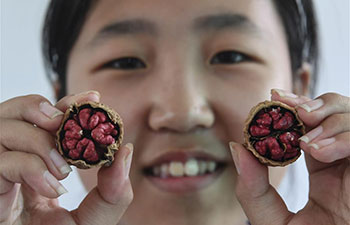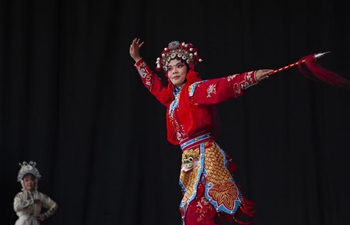JINAN, Aug. 6 (Xinhua) -- Li Huitong is a painter, he draws on the inside surface of snuff bottles usually about half the size of his palm.
What Li makes is called inside painting, or inner painting, which was born after snuffing tobacco was introduced into China during the Ming and Qing dynasties, some 400 years ago. As the habit was taken up by wealthy businessmen, celebrities and influential officials, many began to collect the intricate art works painted by Li's predecessors.
Snuff bottle paintings are produced by manipulating a specialized brush through the neck of the bottle, which requires absolute precision from the artist. "Even the beat of my pulse can lead a painting to be completely ruined," said 51-year-old Li on a piece of paper, as a severe illness left him almost deaf at the age of 10.
Often made of special materials such as jade, crystal and amber, crafting an inside painting requires considerable skill and imagination, as the process of painting is totally reversed.
Most of the inside paintings are Chinese calligraphy and paintings featuring vivid pictures, historic events and elegant layouts, with the smallest as tiny as one centimeter tall.
Li, in the city of Zibo, eastern China's Shandong Province, has been drawing on snuff bottles for over three decades. "I could hardly focus for more than 10 minutes in the beginning," said Li. "I had to keep practising until I could sit still for hours and hold the pen steadily. It took me three years to master how to control my wrist."
One of Li's signature works "Hunting in Mizhou" depicted Su Dongpo, a famous poet and then an official in Mizhou, hunting with his attendants. On the 7-centimeter-tall, 13-centimeter-wide bottle, Li drew over 10 figures hunting on horseback, locating Su along the upper left edge.
"The creation of a painting is like directing a historical movie, you have to arrange figures in their proper positions and shape the characters," he said.
In 2008, his work "Olympic Inside Painting Pot," which he worked on for a whole year, was finished to welcome the 2008 Beijing Olympic and Paralympic Games. The pot incorporated mascots, emblems and competition patterns of the Beijing Olympic and Paralympic Games, and was included in the permanent collection of the China Disabled Persons' Federation.
In 2016, Li was awarded the title of "Chinese Arts and Crafts Master" by the China Arts and Crafts Association.
However, just like many ancient techniques, the art of inside painting lacks successors to carry on the torch.
"First of all, learning inside painting greatly tests the patience and talent of practitioners," Li said, "Not only that, this skill takes up a lot of time and energy, with no immediate payoff on the horizon."
In order to maintain and develop the art of inside painting, Li began cooperating with factories producing similar works to his own. He hopes to take advantage of the factories' connections with several art colleges to look for potential successors.
Now he has had several pupils and his daughter is also learning from him. "I hope more young people can be attracted by the ancient craftsmanship and inside painting can be better passed on and developed," said Li.
(Zhao Lei contributed to the story)

















